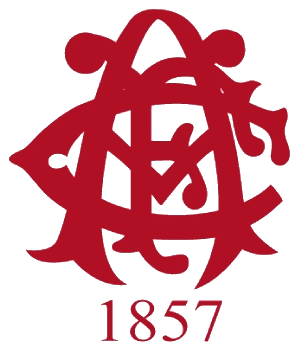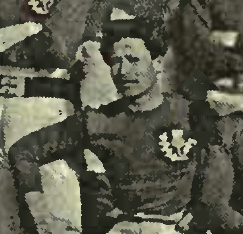
West of Scotland Football Club is a rugby union club based in Milngavie, Scotland. Founded in 1865, West of Scotland are one of the oldest rugby clubs in the world, and one of the founding members of the Scottish Rugby Union. West have enjoyed a long and successful history, winning numerous Scottish Championships and producing an incredible number of international players, and a strong contingent of British and Irish Lions.

Edinburgh Academical Football Club, also known as Edinburgh Accies, is a rugby union club in Edinburgh, Scotland. The club is currently a member of the Scottish Premiership, the top tier of Scottish club rugby. Its home ground is Raeburn Place, in Stockbridge, Edinburgh. The team is coached by Iain Berthinussen.
Edinburgh University Rugby Football Club is a leading rugby union side based in Edinburgh, Scotland which currently plays its fixtures in the Edinburgh Regional Shield competition and the British Universities Premiership. It is one of the eight founder members of the Scottish Rugby Union. In the years prior to the SRU's introduction of club leagues in 1973 and the advent of professionalism in the 1990s, EURFC was a major club power and it won the 'unofficial' Scottish Club championship several times. It remains a club with an all-student committee, and is only open to students of the University of Edinburgh. The club runs a men's team and a women's team; both playing in the university leagues.

Rugby union in Scotland is a popular team sport. Scotland's national side today competes in the annual Six Nations Championship and the Rugby World Cup. The first ever international rugby match was played on 27 March 1871, at Raeburn Place in Edinburgh, when Scotland defeated England in front of 4,000 people. Professional clubs compete in the United Rugby Championship, European Rugby Champions Cup and European Rugby Challenge Cup, while the Scottish League Championship exists for over 200 amateur and semi-professional clubs, as does a knock-out competition, the Scottish Cup. The governing body, the Scottish Rugby Union (SRU), is one of the ten first-tier member nations of World Rugby.
Edinburgh Wanderers is a former rugby union club, founded in 1868. It was latterly a tenant of the Scottish Rugby Union, playing home fixtures at Murrayfield Stadium for nearly 75 years. In 1997 it merged with Murrayfield RFC to form Murrayfield Wanderers.

The 1872 association football match between the national teams of Scotland and England is officially recognised by FIFA as the first international. It took place on 30 November 1872 at Hamilton Crescent, the West of Scotland Cricket Club's ground in Partick, Glasgow. The match was watched by 4,000 spectators and finished as a 0–0 draw.

Rugby union in Scotland in its modern form has existed since the mid-19th century. Scotland has one of the oldest rugby union traditions and has introduced various innovations including rugby sevens.
The Gipsies Football Club was a short lived 19th century rugby football club that was notable for being one of the twenty-one founding members of the Rugby Football Union, as well as producing a number of international players in the sport's early international fixtures.

The 1880–81 Home Nations rugby union matches were a series of international rugby union friendlies held between the England, Ireland, Scotland and Wales national rugby union teams. This season is most notable for the introduction of Wales as an international rugby union nation, playing their first ever match in a game against England. Although Wales were humiliated by a crushing defeat it did not stop rugby union being adopted by Wales as the country's national sport.

The rugby union match played between Scotland and England on 27 March 1871 was the world's first international rugby match. It is also officially the first international football match in any football code. The match was played at Raeburn Place, Edinburgh in front of 4,000 spectators. Scotland won the match, scoring two tries and a goal to England's single try.
There was a single international friendly between the England and Scotland national rugby union teams in the 1871–72 season. With no other recognised rugby union teams in Great Britain or the rest of the world, the encounter between Scotland and England represented the only possible match that could be arranged, and would continue as such until 1875, when Ireland formed their national team.

Francis Luscombe was a rugby union international who represented England from 1872 to 1876. He also captained his country.

Alfred Clunies-Ross was a rugby union international who represented Scotland in the first international rugby match in 1871.

John Shaw Thomson was a rugby union international who represented Scotland in the first international rugby match in 1871.

Powderhall Stadium, formerly the Powderhall Grounds, was a multi-sports facility overlooking the Water of Leith on Beaverhall Road, in the Powderhall (Broughton) area of northern Edinburgh, Scotland. It opened in January 1870 at the height of professional pedestrianism and was modelled on the stadium at Stamford Bridge in London. It hosted professional sprint races, track and field athletics, including the Scottish Amateur Athletics Championships on a number of occasions, professional football, international rugby, cycling, and dog races as well as boxing, quoits and pigeon shooting. For 100 years it hosted the Powderhall Sprint, the most famous professional sprint handicap in the world. With the decline of pedestrianism as a spectator sport in the 1920s it was converted to a greyhound stadium, hosting the Scottish Grand National for over sixty five years, and it also hosted professional speedway. The stadium finally closed in 1995 and the site is now a housing estate.
Glasgow District is a Scottish amateur rugby union team which plays in the amateur Scottish Inter-District Championship. The side evolved into the professional provincial side Glasgow Warriors when the Scottish Rugby Union embraced professionalism. However the amateur district is still used for the representation of amateur players in the Inter-District Championship; and this amateur championship guides the selection of Scotland Club XV international players.
Edinburgh District is a Scottish amateur rugby union team which plays in the amateur Scottish Inter-District Championship. Its draws its players mainly from the Edinburgh area, as well as others from the rest of east central Scotland; roughly corresponding to the old Lothian regional council area. Historically the Edinburgh District team played matches against touring teams visiting Scotland from abroad, and also competed in the Scottish Inter-District Championship.
Scotland's District rugby union sides are provincial representative teams, that in the amateur era capped the best amateur players from their area's club sides to play inter-district matches and matches against touring sides. These districts still survive at amateur level playing in an amateur Inter-District Championship and age-grade. The professional teams Glasgow Warriors and Edinburgh Rugby remain provincial sides based on the traditional districts.
The 1872-73 Scottish Districts season is a record of all the rugby union matches for Scotland's district teams.
The Scottish Unofficial Championship was the top league of Scotland's best amateur rugby union clubs. The Championship was 'unofficial' as the Scottish Rugby Union held that the sport should remain amateur and at the time did not sanction competitive games between the clubs.











